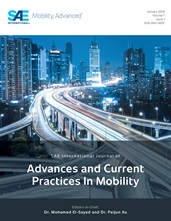Tire/road noise has become a significant issue in the automotive industry, especially for electric vehicles. Among the various tire/road noise sources, the air-cavity mode can amplify the forces transmitted from the tire to the suspension system causing noticeable cabin noise near 200 Hz. Furthermore, when the tire is deformed by loading, the fundamental air-cavity mode separates into two acoustic modes, a fore-aft mode and vertical mode due to the break in geometrical symmetry. This is important because the two components of the split mode can increase force levels at the hub by interacting with neighboring structural modes, thus resulting in increased interior noise levels. In this research, finite element simulations of five commercial tires at rated load were performed with a view to identifying the frequency split and its interaction with structural resonances. These results have been compared with previously obtained empirical results. Both mobility and dispersion diagrams reveal similar patterns as in the testing. Further, for three tires, the relation between the frequency split and the applied load was investigated, indicating that the split was enlarged with increased load level as a higher order function of load.
